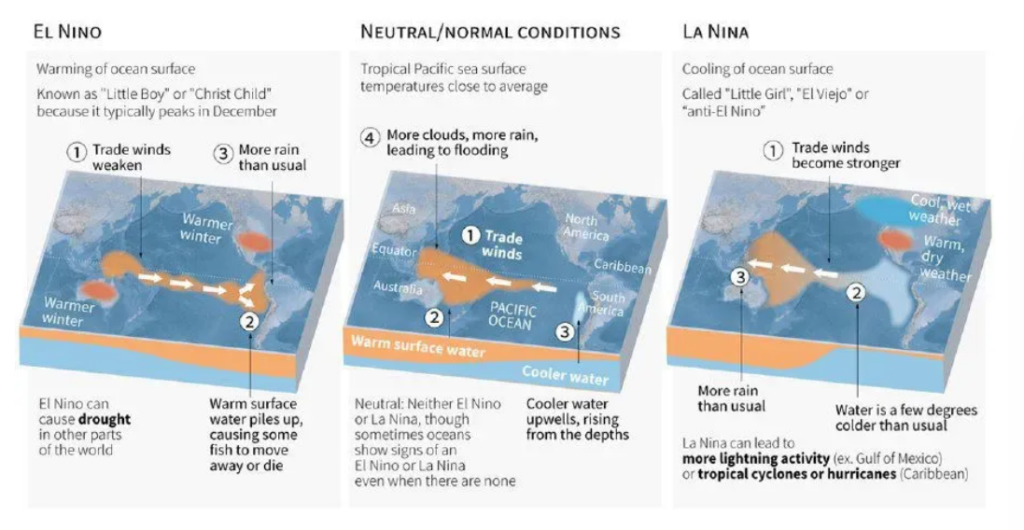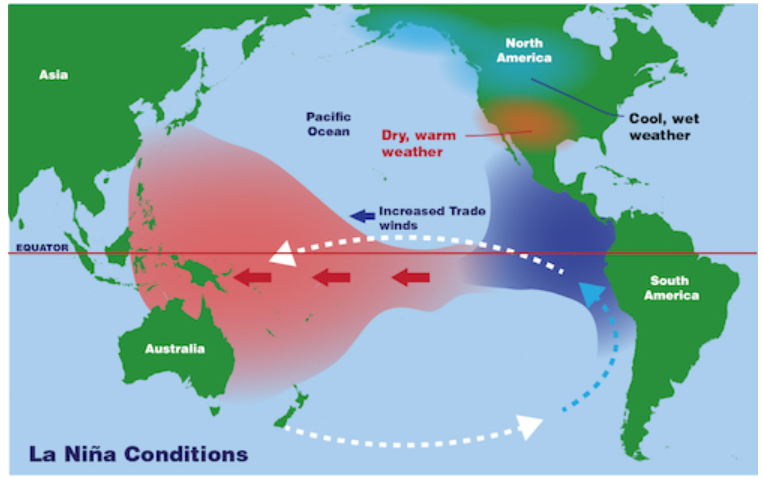1 October 2024 : Indian Express Editorial Analysis
1. The La Nina shadow
(Source: Indian Express; Section: The Editorial Page; Page: 10)
| Topic: GS1– Geography |
| Context: |
| The article discusses the delayed onset of La Niña, the late monsoon retreat, and their impact on worsening air quality in Delhi and northern India during the upcoming winter. |
What is El Nino and La Nina?
- El Nino (or ‘The Little Girl’ in Spanish) and La Nina (or ‘The Little Boy’ in Spanish) are two opposing climate trends that deviate from the normal conditions and normally run 9 to 12 months.
- El Nino (which is more frequent than La Nina)) is typically known as the warm phase of ENSO, in which a band of warmer water spreads from west to east in the equatorial Pacific Ocean.
- On the other hand, La Nina is identified as the cold phase of ENSO, in which a band of cooler water spreads east-west in the equatorial Pacific Ocean.
- Both El Nino and La Nina can have global effects on weather, wildfires, ecosystems and economics.

Delayed Onset of La Niña and Monsoon Retreat

- The delayed onset of La Niña and the later retreat of the monsoon have raised concerns over air quality in Delhi, reversing earlier optimism for improved air conditions this winter.
- La Niña, known for its impact on atmospheric circulation, typically brings stronger winds and improved pollutant dispersion. However, with its delay, combined with the monsoon’s prolonged retreat, north India is expected to face significant pollution challenges in the early winter months.
- The uncertainty surrounding La Niña has complicated expectations, with the possibility of some relief only by December or January, depending on how quickly La Niña conditions strengthen.
- If stubble burning, a major seasonal contributor to pollution, occurs even at half the intensity of previous years, the air quality situation could deteriorate significantly in November.
Climate Change, La Niña, and Air Quality
- Recent research by the National Institute of Advanced Science (NIAS) has highlighted the intricate links between climate change, La Niña, and air quality.
- Their study emphasized the positive impact of La Niña during the winter of 2022-23, when Delhi experienced its cleanest air in a decade. However, the current unpredictability of La Niña has introduced uncertainty into the winter air quality forecast.
- While La Niña typically strengthens monsoons in India, its late onset, coupled with ongoing climate change, adds complexity to predicting air quality this winter.
- Gone are the days when air pollution was considered solely a local issue; today, it is deeply intertwined with global meteorological patterns and the changing climate.
Emission-Centric vs. Meteorological Approach
- The traditional “emission-centric” approach to air pollution, which focused primarily on local emissions, is no longer sufficient. Researchers are increasingly recognizing the need to account for broader meteorological and climatological processes that impact air quality.
- In the context of Delhi’s air, where pollution worsens during the winter, larger atmospheric circulations such as the El Niño-Southern Oscillation (ENSO) and wind pattern changes play critical roles.
- The transport of pollutants over long distances, sometimes from neighboring regions or even other countries, complicates the air quality management landscape.
- For policymakers, it is essential to maintain focus on PM2.5, a harmful pollutant, rather than over-prioritizing PM10 and dust sources, as has sometimes been the case.
Atmospheric Conditions and Their Role in Air Quality
- The NIAS-SAFAR model indicates that the delayed retreat of the monsoon, combined with slower La Niña development, presents a serious threat to air quality in Delhi this winter.
- The monsoon’s extended withdrawal usually leads to high humidity, calm winds, and anti-cyclonic circulation, all of which contribute to poor atmospheric mixing and pollutant dispersion. This results in elevated levels of PM2.5 and PM10, trapping pollutants near the surface.
- Without strong winds to disperse emissions, local pollution and transboundary pollutants from neighboring areas will continue to degrade air quality.
The Impact of Stubble Burning and La Niña
- The delay in La Niña conditions also heightens concerns about stubble burning in northern India, particularly in Punjab and Haryana. With north-northwesterly winds dominating the region and the absence of La Niña’s typical wind patterns, smoke from agricultural burning is likely to significantly affect air quality in Delhi.
- Stubble burning is a recurring issue during autumn and early winter, and in the absence of favorable meteorological conditions, its effects could worsen the already grim situation.
- However, if La Niña develops by December, as predicted by some meteorologists, stronger winds could potentially improve air quality by dispersing pollutants.
Uncertainty and the Role of Climate Change
- While a late La Niña might provide some relief in December or January, it also brings challenges.
- Stronger winds, fewer clouds, and feeble westerly disturbances may help clear pollutants, but the lowering of the inversion layer during a severe winter could trap pollutants closer to the ground, limiting the benefits of La Niña.
- This means that even with La Niña, the winter pollution situation in Delhi and northern India will remain problematic.
- The NIAS-SAFAR model further suggests that had La Niña settled in by July, as originally predicted, it could have worsened air quality in the country’s peninsular regions by up to 20%, while providing some improvements in the northern areas.
Rethinking Air Quality Management
- The complexities introduced by climate change and shifting meteorological patterns demand a reevaluation of air quality management strategies. Extreme pollution events are increasingly linked to broader climatic changes, in addition to local emissions.
- As such, a shift in focus from isolated cities to larger airsheds is essential. Air quality strategies must integrate scientific insights into broader climatic and meteorological processes, ensuring health-centric measures are prioritized.
- Collaboration between scientific bodies and government agencies, particularly through the office of the Principal Scientific Advisor, can help create a resource framework to better address the evolving air pollution challenges.
| Effects of La Niña Phenomenon |
|
|
PYQ: With reference to ‘Indian Ocean Dipole (IOD)’ sometimes mentioned in the news while forecasting Indian monsoon, which of the following statements is/are correct? (2017) 1) IOD phenomenon is characterised by a difference in sea surface temperature between tropical Western Indian Ocean and tropical Eastern Pacific Ocean. 2) An IOD phenomenon can influence an El Nino’s impact on the monsoon. Select the correct answer using the code given below: (a) 1 only (b) 2 only (c) Both 1 and 2 (d) Neither 1 nor 2 Ans: (b) |
| Practice Question: Discuss the impact of the delayed onset of La Niña and late monsoon retreat on air quality in Delhi and northern India. How should policymakers adapt their strategies to address the challenges? (250 words/15 m) |





